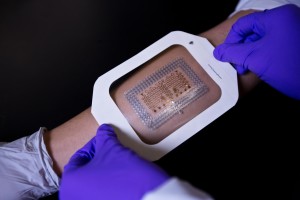 You track your exercise program with electronic bracelets and watches. Why not track your health with an electronic patch? Nicotine and pain medication dermal patches have been a boon to a lot of us. Now it looks as if medical patches can go electronic, and electronic medical patches just take a giant step forward thanks to some researchers at The University of Texas in Austin.
You track your exercise program with electronic bracelets and watches. Why not track your health with an electronic patch? Nicotine and pain medication dermal patches have been a boon to a lot of us. Now it looks as if medical patches can go electronic, and electronic medical patches just take a giant step forward thanks to some researchers at The University of Texas in Austin.
These patches can be made with existing technology, but they are made one at a time, making them seriously cost-prohibitive. However, some folks at UT Austin’s Cockrell School of Engineering have developed a way to cut down the time it takes to make a single patch from more than one day to 20 minutes, while eliminating the need for a clean room and other expensive equipment.
“One of the most attractive aspects of epidermal electronics is their ability to be disposable,” said UT Assistant Professor Nanshu Lu, who led the development team. “If you can make them inexpensively, say for $1, then more people will be able to use them more frequently. This will open the door for a number of mobile medical applications and beyond.”
The process cuts shapes out of metal and prints the result on polymer adhesives. It works like Michelangelo sculpted; taking away the unnecessary parts to get at the shape you want. It is also programmable, so it can be used to make more than one kind and size of patch. Developers of the patent-pending process believe it is compatible with roll-to-roll manufacturing, which allows bulk production of the devices.